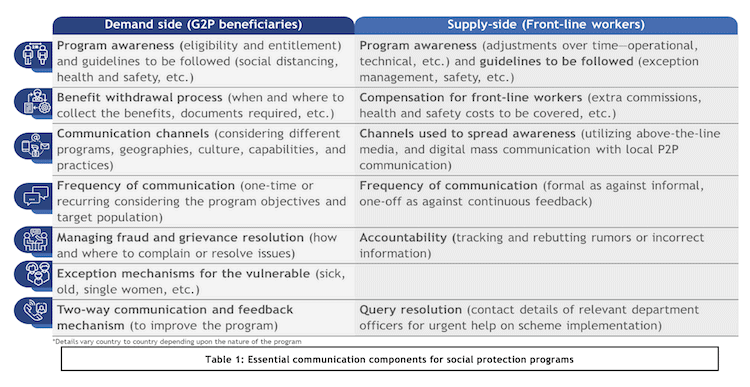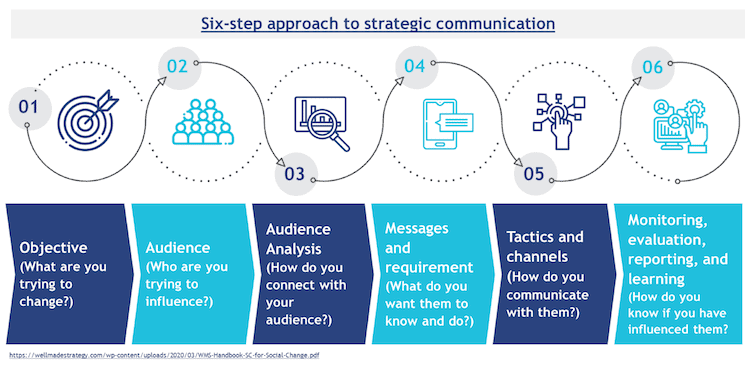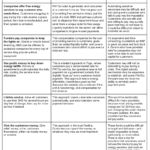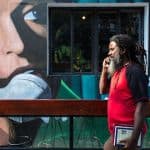Addressing the Weak Link in COVID-19 Relief: How Improving Strategic Communications Can Boost the Impact of Social Protection Programs
In response to COVID-19, 212 countries have planned or implemented more than 1,100 social protection programs to help over 1.8 billion people (as of September 2020). But while this looks impressive on paper, many of these programs’ intended recipients don’t know about the programs, or how to access these funds. For example in India, less than 50% of the intended beneficiaries of the government’s COVID-19 relief package were aware of the benefits available to them.
This is because communication around these programs is often weak and poorly targeted. Poor communication results in exclusion, misinformation and rumors, which in turn lead to a negative spiral of perceptions, lack of credibility, and reduced opportunities to optimize the uptake and impact of the programs.
Below, we’ll discuss the importance of raising awareness of social protection programs, particularly in light of the pandemic, and explore how governments and program administrators can improve their communication to vulnerable populations. Though this issue is global, we’ll use examples from MSC’s research in India and Indonesia.
Communication is consistently the weakest link in social protection programs
Communication is often ignored as a core design principle of social protection programs, and is at best an afterthought for those who implement them. The effective implementation of programs depends heavily on maintaining regular and clear communication with stakeholders on both the demand and supply sides. Most programs kick off with outreach to build awareness and encourage active participation from potential applicants. The core outputs of the outreach campaigns, however, are limited to disseminating macro-level information about the programs.
On the demand side, program recipients or applicants need more nuanced, micro-level information on the eligibility criteria, registration process, access to entitlements, and grievance resolution mechanisms for these programs, among other details. For instance, program applicants are rarely notified of their selection in a program or rejection from it, leaving no scope for corrections if their application is rejected due to the lack of a particular document. On the supply side, frontline workers – such as banking or mobile money agents and the government officials who work to ensure the effective distribution of program benefits – also need the nuanced information outlined above. Though these frontline workers are providing the benefits, some of them may not be aware of the many details of eligibility requirements, complaint resolution processes, and other elements of the program’s operation. In order to implement the programs effectively, they also need clarity in terms of their shifting roles as beneficiaries increase, their remuneration (e.g.: when commissions are involved), and ways to counter misconceptions and rumors among program recipients.

MSC’s assessment of the Indian government’s social protection response to COVID-19 suggests that only 41% of the program recipients were fully aware of the benefits they were eligible to receive. But the low levels of awareness of social protection programs are not limited to any particular country, or to the context of the current pandemic. For instance, the awareness level among recipients of Indonesia’s Program Keluarga Harapan was around 50%, according to MSC’s evaluation report from 2019.
Inadequate information can confuse program recipients, waste time and resources, and generate inefficiencies that reduce the effectiveness of the overall program implementation. While evidence suggests that governments and policymakers have made communication mistakes in the past, they recognize the need to strengthen communications for social protection programs going forward.
COVID-19 has complicated communication and outreach for social protection programs
Governments around the world have announced many policy changes and improvements in their existing social protection programs to expand their reach to the last mile. However, communication about this expanded outreach is often not updated adequately. This issue is particularly important to address now that governments are establishing or expanding cash transfers as a social protection response to COVID-19, with an increased emphasis on digitization to deliver safe, secure and convenient payments. Administering these programs safely and inclusively can require special procedures and requirements, which increases the need for clear communication.
For instance, in India, the government distributes cash and other benefits after adequate beneficiary authentication, usually using the biometric Aadhaar system. But a few state governments in India have laid down exception management guidelines, an alternate mechanism to provide benefits to vulnerable individuals who might not meet eligibility requirements like biometric identification. In other cases, programs have suspended biometric authentication entirely to mitigate the spread of infection, or provided doorstep delivery of food benefits to recipients so they don’t have to leave home and risk exposing themselves to the virus. However, since many recipients were not aware of these new program approaches and guidelines, they’ve struggled to access their benefits.
The lack of awareness of the changes in entitlements, eligibility conditions, available programs and modes to withdraw benefits tend to leave vulnerable people without access to the benefits. MSC’s work in India suggests that frontline workers and word-of-mouth communication are important sources of information for recipients of social protection programs. However, even frontline workers have faced several challenges that have prevented them from getting correct information during the strict lockdown imposed across the country. They’ve struggled with poorly coordinated and delayed information when the government has announced changes related to programs, operations and technical aspects of benefit delivery.
To address these issues, an effective communication strategy must be designed that incorporates a range of considerations and components for stakeholders on both the supply and demand sides.
Vulnerable groups need more attention and customized communication
Children and adults with disabilities make up an estimated 15% of the global population, and they are often invisible and excluded. They are likely to become even more vulnerable during emergencies like COVID-19. In particular, people with disabilities, indigenous and migrant populations, and people who live in remote areas are more likely to miss out on necessary information that would help them receive social program benefits. These communities depend mostly on the informal economy, and they have low literacy levels and limited access to technology and the internet. Many women are similarly challenged as a result of male-centric socioeconomic norms — communication strategies must therefore have a gender-intentional design.
These high-risk and vulnerable groups need specific interventions to overcome existing communication barriers. These barriers include:
- Obstacles related to identity, culture, language and norms
- Social, environmental, economic and geographic barriers
- Lack of participation and community engagement
- Fear, hesitation and other behavioral obstacles
- Lack of access to media or digital channels
- Disability (including lack of mobility and health issues)
A focused communication plan that targets each of these barriers is essential. Recruiting or training multilingual staff, providing information in multiple and accessible formats, and promoting community engagement with the involvement of community leaders, frontline workers and women can ensure active outreach to these vulnerable groups.
A strategic approach can help improve communication significantly
Countries around the world have developed innovative solutions to informing potential recipients of pandemic-related relief programs. For instance, local governments or community leaders are identifying eligible individuals for COVID-19 relief for a cash transfer program in Brazil. Individuals there receive SMS messages in the local language that direct them to open an account via WhatsApp or through a Facebook chat message. And in Kenya, a community organization called Hope Raisers has used murals painted on walls to raise awareness and spread information about safety measures to protect against the pandemic. They’re focusing on people in informal settlements, who have limited or no access to social and mainstream media, which makes them more vulnerable during COVID-19.
Social protection programs need a well-designed strategy on communication and outreach to be effective in reaching communities like these. Well Made Strategy’s six-step framework provides an approach for developing impactful communications to enhance outreach campaigns designed in response to the crisis, and improve participation in social schemes. The framework integrates several essential communications components into the following steps:
- Objective: Define the communication objectives clearly, as multiple policy changes and reforms announced during a crisis can confuse vulnerable people
- Audience: Customize the content and frequency of communication, based on the nature and involvement of the many stakeholders involved in the program
- Audience analysis: Identify and analyze the stakeholders addressed by the communication strategy to tailor messages, channels and “teachable moments” to them
- Messages and requirement: Ensure the messaging is on-brand, clear, continuous and tailored for program recipients and front-line workers, to enhance the efficiency and accessibility of cash transfer or food relief programs
- Tactics and channels: Adopt the use of multiple communication channels — and remember that the efficacy of a channel depends on its outreach, engagement and cost-effectiveness
- Monitoring, Evaluation, reporting and learning: Ensure that communications are strategic: Understand and learn from what works, what does not, when and for whom, and make changes accordingly

We believe the use of Well Made Strategy’s framework for communication can help governments and implementers of relief programs assess the effectiveness of their existing communication strategies. The framework will also ensure that governments use communication as a strategic tool to strengthen stakeholder participation and improve the design and delivery of social protection programs.
Read more discussions of these ideas and case studies from across the globe here.
Arshi Aadil is a Manager and Abhishek Jain is an Assistant Manager in the Digital Financial Services – Government and Social Impact domain of MSC India. MSC is a NextBillion partner.
Photo credit: Yuri Samoilov
- Categories
- Coronavirus, Finance, Impact Assessment




